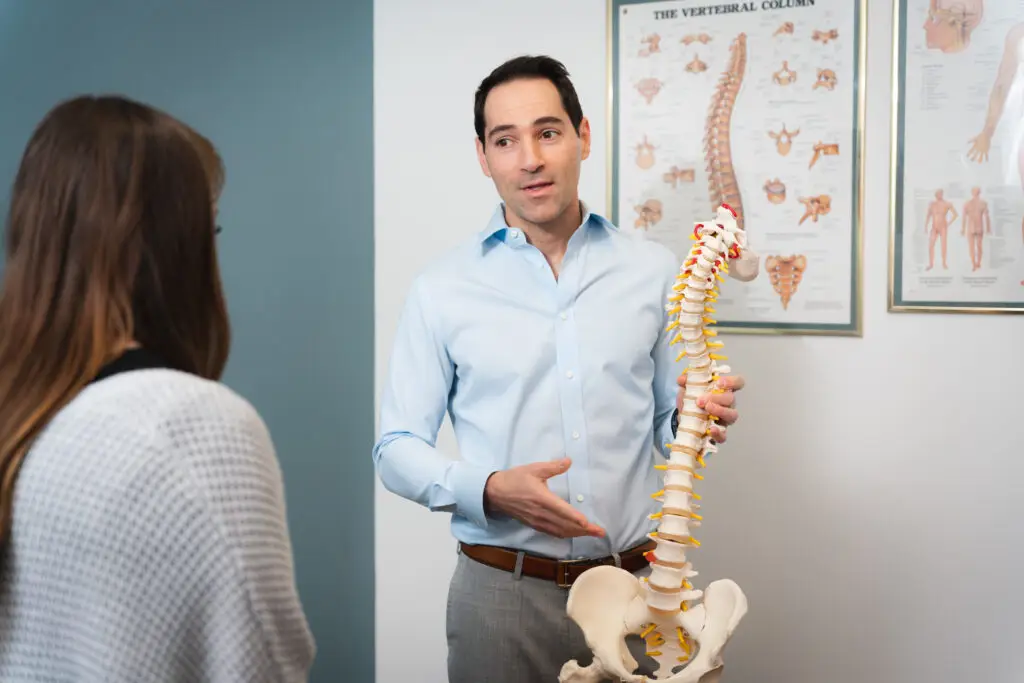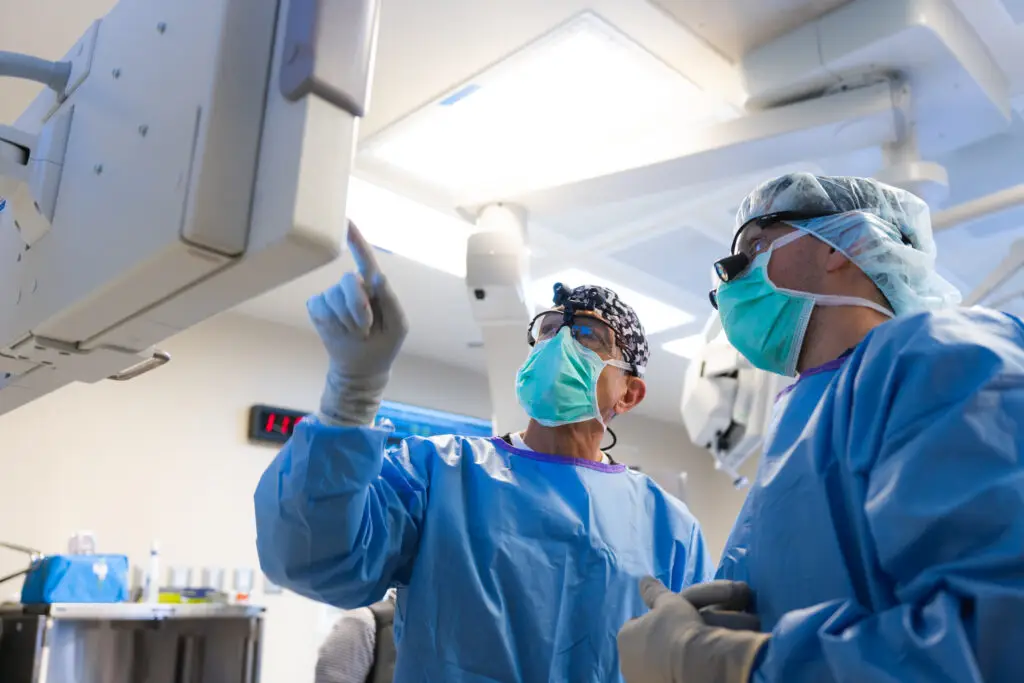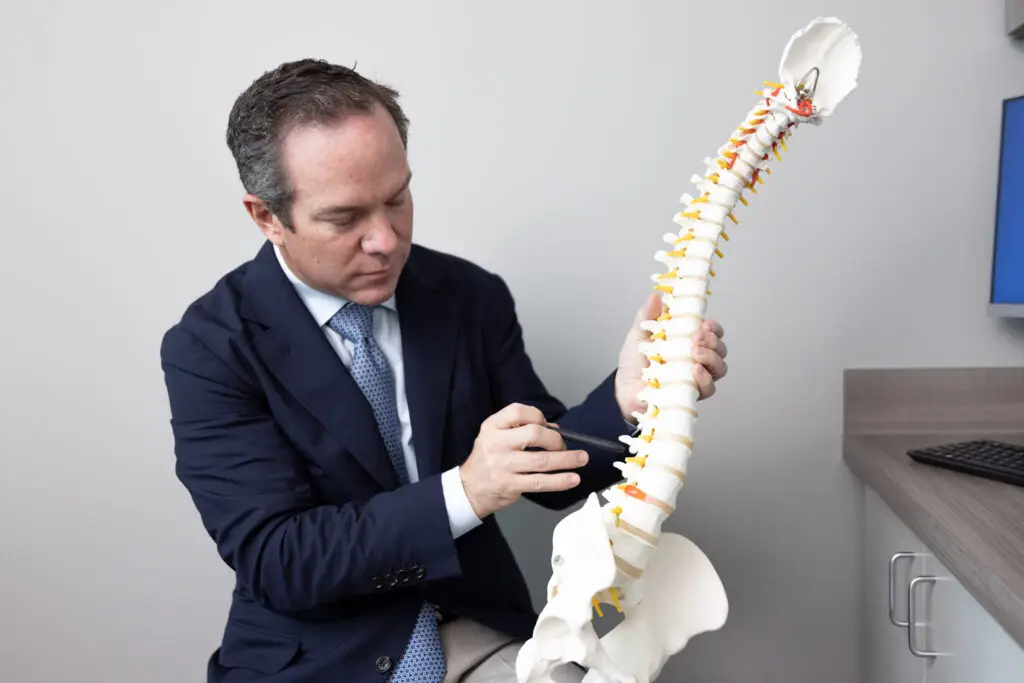Kyphoplasty: A Minimally Invasive Procedure to Treat Spinal Fractures
how we can help
Kyphoplasty Overview
In many ways, spine surgery requires an understanding of structural engineering. The spinal column is analogous to an intricately designed structure which might require periodic repairs. Just as buildings can be damaged by fires, natural disasters and common wear and tear, the bones of the spine will sometimes break. This is when procedures such as kyphoplasty are performed by a spine surgeon.
Kyphoplasty is a minimally invasive procedure used in the treatment of compression fractures in the spine. Compression fractures are small breaks in the vertebrae, which are the bones in the spine. As bones weaken with age, become diseased with spinal tumors which causes weakening, impacted by trauma from an accident or perhaps the bone thinning disease of osteoporosis, they are more likely to break. Over time, breaks in the vertebrae cause the spine to collapse and curve over. a curve in a person’s spine makes it appear as if they are hunched over. It can limit breathing or the function of the abdominal organs. Kyphoplasty prevents this curve from happening
These breaks are more common in women over 50 and this is due largely to the incidence of osteoporosis among this group. According to the National Institute of Health, one in five women, who are 50 years of age and older, will suffer from osteoporosis. This compares to one in 20 men who are in this demographic.
Treatment for compression fractures can include rest, medications, braces and, when there is more serious damage, kyphoplasty. This procedure is minimally invasive and as such does not require any incisions. The supporting material for the damaged vertebra is delivered via a small needle, Kyphoplasty treats spinal compression fractures using a balloon-like device to prevent bones from collapsing. With the kyphoplasty procedure, a balloon is first inserted and inflated to expand the compressed vertebra to its normal height before filling the space with bone cement carried by the needle. In some cases, the patient may hear their healthcare provider refer to kyphoplasty as a “balloon kyphoplasty.”
Table of Contents
Treats
Diagnosing
Recovery
Patients Ask:
How long does a typical kyphoplasty procedure take and what does the recovery process involve?
Texas Back Institute Responds: The procedure will take less than an hour to complete, and since it is minimally invasive, there are no stitches required. This makes the recovery much quicker and less likely to have complications. You will spend time in a recovery room, and you could go home the same day, but your doctor may want you to stay overnight.
It’s possible that you can start walking an hour after the procedure. You may feel some soreness where the needle enters your back, but this lasts no more than a few days. You may quickly notice that you have less pain than you did before the surgery.
Understanding Vertebral Fractures
When discussing kyphoplasty with a spine specialist at Texas Back Institute, is it useful to have a general understanding about vertebral fractures. A vertebral fracture refers to a broken bone in the spine, usually due to trauma (injury). A fracture can occur without injury when there is weakness in the bone due to osteoporosis, abnormal stress, tumor, or a combination of these things.
Fractures most often present with pain in the region of the body where the fracture has occurred. You may also experience pain from nerve impingement in the spine, including either the spinal cord or individual nerve roots (or all the above).
With nerve root impingement, there may be pain/numbness/tingling/weakness in an arm or leg. With spinal cord impingement or injury, there may be more extensive pain/numbness/tingling and/or weakness in the arm(s) or leg(s). The symptoms depend on the pattern and severity of the fracture, which depends upon the nature of the cause, the energy involved, and patient factors such as bone strength and quality.
Most fractures are not associated with any other problems or symptoms, other than the pain of the fracture itself. If a fracture is not causing any jeopardy to nerves or the spinal cord, and if it is a pattern that has a good chance of healing in time without any treatment, then it is considered “stable”.
An “unstable” fracture is one that leads to an unacceptable risk of neurologic injury or deformity or has a high likelihood of progressively worsening or simply failing to heal in time. The difference between a stable and unstable fracture is determined over a period of observations. Additional factors must be considered which may require interpreting several tests/x-rays over time.

Patients Ask:
How do I know if I am a candidate for kyphoplasty?
Texas Back Institute Responds: You may be a candidate for kyphoplasty if you have painful, worsening back pain caused by a compression fracture. You may not be able to move or function as well as you used to because of the fracture. To benefit from kyphoplasty your pain must relate to the compression fracture, not another condition like disk herniation, arthritis or stenosis.
We will perform imaging tests to confirm the presence of a vertebral fracture. Plus, if you have osteoporosis, we may order a dual-energy X-ray absorptiometry (also called a DXA) scan. This bone density test is a quick, painless way to check your bone health. It’s similar to a regular X-ray but measures the strength and mineral content of your bones instead of just taking pictures of them. These scans screen you for osteoporosis, osteopenia and other conditions that can silently weaken your bones.

Preparation for a Kyphoplasty Procedure
At Texas Back Institute, surgery is always the final option. However, if conservative measures such as anti-inflammatory medicine, physical therapy and lifestyle changes do not result in pain reduction, surgery to repair a condition such as compression fractures may be recommended.
Here’s what to expect before the kyphoplasty. An appointment will be scheduled for the following:
- Texas Back specialist will perform a physical exam.
- They will order a spine X-ray, CT (computed tomography) scan or MRI (magnetic resonance imaging).
- Recent illnesses will be discussed.
- Any allergies you may have will be discussed
- Any medications being taken will be discussed.
- Blood tests will be ordered.
- They’ll also schedule the date of your surgery during this visit so you have time to prepare for it.
Your surgeon will give you specific instructions before your surgery, such as
- Don’t continue certain medications, like blood thinner.
- Take certain medications prescribed by your surgeon before the date of your surgery.
- Don’t eat or drink anything for up to three hours before the procedure.
- Don’t wear jewelry on the day of your procedure and wear loose, comfortable clothing.
- Reduce or stop smoking.
What to Expect on the Day of the Procedure
Because kyphoplasty is a minimally invasive spine surgery, accomplished with a small needle and no incisions, the surgery is much less likely to lead to complications such as excessive bleeding or any muscle or tissue damage. It is typically done on an outpatient basis.
On the day of your surgery, an anesthesiologist will give you moderate sedation, depending on what the surgeon needs to accomplish. With moderate sedation, you’ll feel minimal discomfort.
You will lie on your stomach during the kyphoplasty procedure. The TBI surgeon will insert a hollow needle, called a “trocar,” through your skin and into the affected bone in your spine. This instrument is guided into the proper position by an X-ray called a fluoroscopy (link to page on the website).
Once the trocar is in place, your surgeon will put an inflatable, balloon-like device into your vertebra through the trocar. As the balloon inflates, it helps regain vertebral height and opens a space for your surgeon to inject bone cement there. The cement prevents your bones from further collapsing.
Once the cement is properly inserted into the fractured bone, your surgeon will remove the needle, with no stitches needed. The entire procedure will probably take less than an hour, though it may last longer if more vertebrae are treated.
With more than 19,000 of these procedures being conducted each year, this procedure has proven to be reasonably safe. However, complications are always possible with any surgery. In the case of kyphoplasty, complications can include:
- Infection
- Bleeding
- Increased back pain
- Tingling, numbness or weakness because of nerve damage
- Allergic reactions to chemicals used with X-rays to help guide the doctor
- The bone cement leaking out of position

Pars Fractures
A pars fracture is also known as Spondylolysis and is a stress fracture of the spine that is common in young athletes, especially those who repeatedly bend backwards during activity, such as gymnasts.
This condition is a spinal defect or fracture of a bone structure called the pars interarticularis, which connects the facet joints of the spine. The condition is sometimes also called by the shortened names, “pars defect” or “pars fracture.”
The spinal cord is protected by rings of bone that make up the middle and posterior (rear) portion of the spinal column. In each of these rings, the pars interarticularis (or simply “pars” for short), located on each side of the vertebra, connects other components of the ring, known as the pedicle and lamina.
The spine specialists at Texas Back Institute note that pars fractures most commonly occur in the lowest lumbar vertebra (L5) of the lower back (lumbar spine). In athletes, this type of injury can be seen when the back is bent backwards repeatedly, in activities such as gymnastics, karate and other martial arts. It is also common in soccer, lacrosse and basketball players. In football players, it is especially common in offensive and defensive linemen.
With pars fractures or spondylolysis, the symptoms usually respond favorably to physical therapy and activity modification. In some instances, however, there may be persistent symptoms that necessitate surgical intervention. This usually occurs when one or more vertebrae slip out of place relative to one other or if there is persistent back pain.
In these cases, surgical options usually include lumbar spinal fusion or direct repair of the fracture, which might be treated with the kyphoplasty procedure. If there is pinching of a nerve associated with a spondylolysis, a spinal decompression surgery (also called a laminectomy) may be necessary. Only a spine specialist can help patients understand the options and potential complications of this treatment.

Are You Ready to Live Life Without Back Pain?
For more than 45 years, the spine surgeons at Texas Back Institute have been on the forefront of spine care innovations. With state-of-the-art technology and constantly evolving training of every surgeon, patients can feel confident that they are being treated by some of the best spine surgeons in the world.
If you’re ready to improve your quality of life and live pain free, contact us for an appointment.
Learn more
Frequently Asked Questions
The procedure will take less than an hour to complete, and since it is minimally invasive, there are no stitches required. This makes the recovery much quicker and less likely to have complications. You will spend time in a recovery room, and you could go home the same day, but your doctor may want you to stay overnight.
It’s possible that you can start walking an hour after the procedure. You may feel some soreness where the needle enters your back, but this lasts no more than a few days. You may quickly notice that you have less pain than you did before the surgery.
You may be a candidate for kyphoplasty if you have painful, worsening back pain caused by a compression fracture. You may not be able to move or function as well as you used to because of the fracture. To benefit from kyphoplasty your pain must relate to the compression fracture, not another condition like disk herniation, arthritis or stenosis.
We will perform imaging tests to confirm the presence of a vertebral fracture. Plus, if you have osteoporosis, we may order a dual-energy X-ray absorptiometry (also called a DXA) scan. This bone density test is a quick, painless way to check your bone health. It’s similar to a regular X-ray but measures the strength and mineral content of your bones instead of just taking pictures of them. These scans screen you for osteoporosis, osteopenia and other conditions that can silently weaken your bones.
Locations


